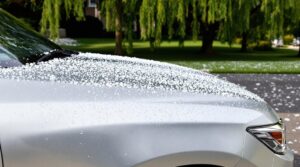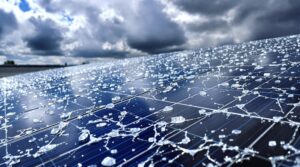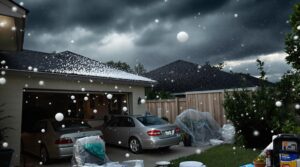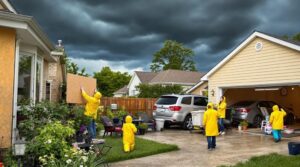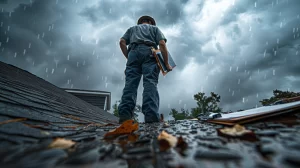During a hail storm, immediate shelter in a secure building away from windows and skylights is essential. Individuals caught outdoors should protect their heads with thick clothing, blankets, or helmets. Drivers must reduce speed, activate hazard lights, and maintain triple following distance from other vehicles. Seeking cover under sturdy structures like gas station canopies offers temporary protection. Understanding thorough safety protocols and proper insurance coverage maximizes protection for both life and property.
Key Takeaways
- Seek immediate shelter in a secure building and stay away from windows, doors, and skylights to avoid injury.
- If outdoors, protect your head and eyes with thick clothing, blankets, or helmets until reaching shelter.
- When driving, reduce speed, turn on hazard lights, and maintain triple following distance from other vehicles.
- Keep emergency communication devices charged and monitor weather alerts for storm updates and safety instructions.
- If caught in a vehicle, try to find protective cover like a gas station awning, avoiding areas with falling tree branches.
Understanding Hail Storm Dangers and Warning Signs
While hailstorms occur with relative frequency across the United States, their destructive potential poses significant risks to both life and property. Annual hail damage costs range between $8-14 billion, with over 6.8 million properties affected in 2021 alone, resulting in $16.5 billion in damages.
Key warning signs of hail damage include destruction to landscape features, compromised drainage systems, and impacts on exterior equipment. Damaged bushes, trees, and dented downspouts often indicate significant roof damage. Air conditioning units with bowed aluminum fins and dented mailboxes serve as essential indicators of storm severity. Additionally, visible dents in siding and window frames suggest the need for thorough property assessment.
For effective storm preparedness, property owners should monitor both seasonal patterns and physical indicators. Spring and autumn represent peak hail seasons, with hail larger than quarter-inch diameter capable of causing substantial structural damage.
Essential Steps to Prepare Your Property
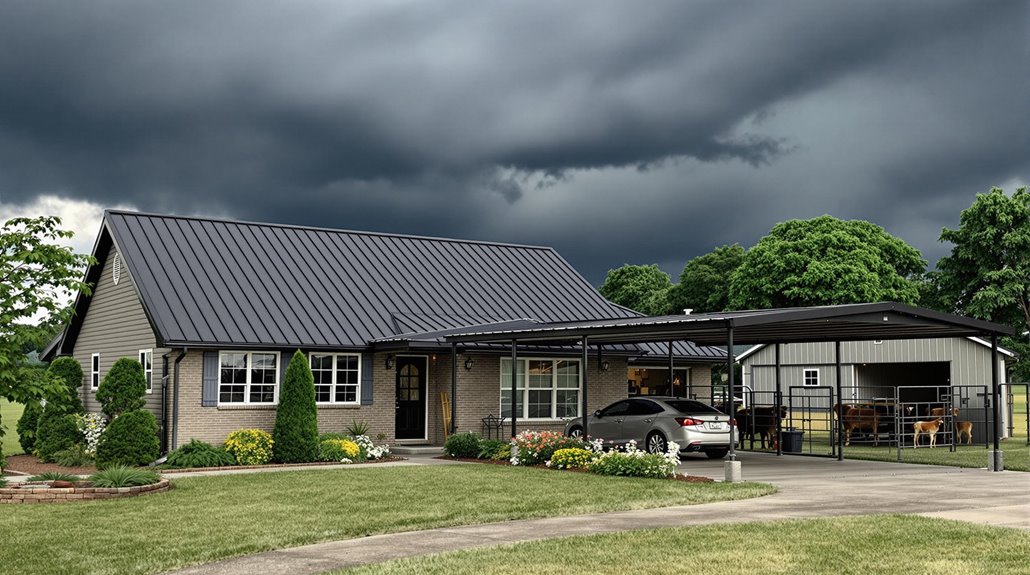
Property protection against hailstorms requires systematic preparation across multiple structural components and outdoor elements.
Effective storm preparedness begins with thorough roof inspections and the installation of impact-resistant materials rated UL 2218 Class 4. Regular property maintenance includes clearing gutters, trimming hazardous trees, and securing outdoor fixtures to prevent wind-propelled projectiles.
Windows and doors require specific fortification through the installation of storm shutters or impact-resistant glass. Protective measures extend to outdoor equipment through the implementation of hail guards and mesh shields for rooftop installations.
Vehicle protection necessitates covered parking solutions, while livestock requires accessible shelter options.
Insurance verification and documentation form critical components of preparation, ensuring adequate coverage for potential hail damage.
The development of structured disaster and business continuity plans, combined with scheduled maintenance protocols, establishes a thorough framework for minimizing property vulnerability during severe weather events.
Working with licensed public adjusters can maximize potential settlement outcomes when filing insurance claims for hail damage.
Staying Safe When a Hail Storm Strikes

When severe weather conditions manifest in hailstorms, individuals must execute immediate safety protocols to minimize personal risk. The primary directive is to locate and occupy designated safe spaces within structures, maintaining distance from windows, doors, and skylights to prevent injury from shattered glass. Additionally, individuals should cover any exposed vehicles and outdoor belongings to further protect against hail impact. It’s essential to stay informed by monitoring weather updates and alerts, which can provide critical information on the storm’s development. By understanding how to avoid hail storm damage, homeowners can take proactive measures, such as installing protective screens or using hail-resistant materials for roofs and windows.
For those caught outdoors during a hailstorm, immediate shelter should be sought in secure buildings. If shelter is unavailable, individuals should crouch down and protect their head and neck. Vehicle occupants should move away from windows while maintaining their seated position.
Emergency plans should be activated, guaranteeing all household members and pets remain in protected areas until the threat subsides.
Protection of essential areas, particularly the head and eyes, remains critical throughout the event. Utilizing available materials such as thick blankets, clothing, or helmets can provide additional defense against falling hail and potential glass debris.
Monitoring emergency alerts and maintaining charged communication devices guarantees continued access to important safety information.
Navigating Through Hail While Driving
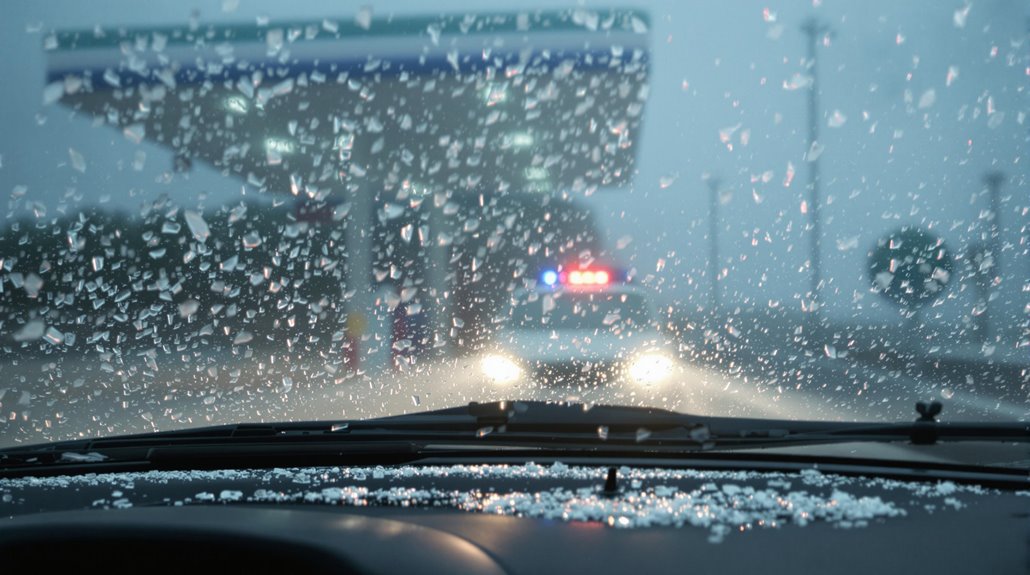
Safe navigation during a hailstorm requires drivers to implement multiple strategic protocols to minimize risk and maintain vehicle control.
Initial measures include reducing vehicle speed and activating hazard lights to enhance visibility while maintaining operational windshield wipers to guarantee clear sightlines.
For the best driving safety during hail impact, operators should activate low beam headlights and triple their standard following distance from other vehicles.
When conditions deteriorate beyond safe driving parameters, drivers should locate protected areas such as gas station awnings or parking structures, explicitly avoiding bridge underpasses due to collision risks.
If shelter proves inaccessible, positioning the vehicle to direct hail impact toward the windshield rather than more vulnerable side windows becomes critical.
Standing water presents additional hazards during hailstorms, necessitating careful navigation to prevent hydroplaning.
Drivers must resist the impulse to accelerate in attempts to escape the storm, as increased speed amplifies both damage potential and accident risk.
Recovery and Insurance Claims After the Storm
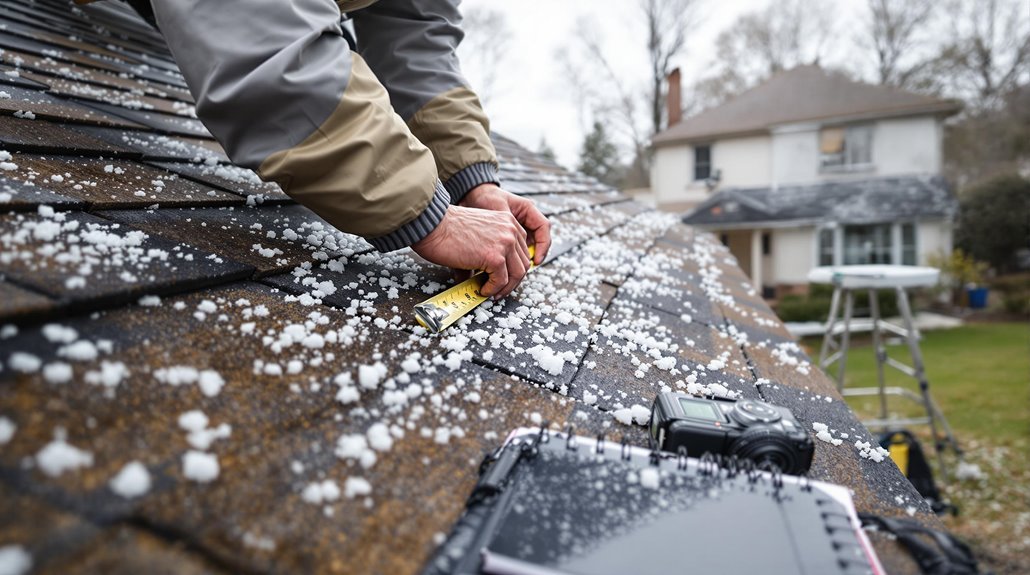
After a hailstorm subsides, extensive damage assessment and documentation become critical steps in the recovery process. Property owners must systematically inspect their premises, focusing on roofs, windows, and outdoor structures while maintaining detailed photographic records of all damage. Insurance documentation should include precise measurements of hailstone sizes and thorough evidence of impact points. Open communication channels with insurance providers and contractors helps ensure a smoother claims process and faster resolution.
| Recovery Phase | Required Actions | Timeline |
|---|---|---|
| Initial Assessment | Property inspection, photo documentation | 24-48 hours |
| Insurance Contact | File claim, schedule adjuster visit | 2-3 days |
| Professional Review | Contractor inspection, damage estimates | 3-7 days |
Claim timelines typically require prompt notification to insurance providers, followed by professional assessments from licensed contractors. Property owners should prioritize temporary repairs to prevent secondary damage while maintaining extensive documentation of all expenses. The recovery process concludes with implementing preventative measures for future storms, including regular maintenance schedules and updated emergency response protocols.
The Benefits Of Consulting A Public Adjuster

Public adjusters offer specialized expertise in guiding complex insurance claims and provide objective assessments of hail damage that maximize compensation for property owners.
These licensed professionals streamline the claims process by managing documentation, coordinating with contractors, and negotiating directly with insurance companies on behalf of policyholders.
Statistical evidence indicates that settlements secured through public adjusters typically result in notably higher payouts compared to claims filed independently by property owners.
Studies demonstrate that claims handled by professional public adjusters achieve up to 800% higher settlements compared to those filed without representation.
Expertise In Insurance Claims
When dealing with the complexities of hail damage insurance claims, consulting a public adjuster offers significant advantages due to their specialized expertise in policy interpretation and claims processing.
These professionals possess extensive knowledge of insurance policies, enabling accurate insurance policy interpretation to guarantee policyholders receive their full entitled benefits.
Public adjusters excel in claims documentation accuracy, meticulously gathering and organizing essential paperwork, including damage assessments and repair estimates.
Their expertise extends to understanding specific procedures for various types of coverage, particularly those related to hail damage claims.
Through their thorough knowledge of insurance industry practices, public adjusters navigate complex claim requirements while ensuring all documentation meets professional standards.
This expertise proves invaluable in presenting detailed claims that maximize the likelihood of fair settlements for policyholders.
Unlike insurance company adjusters who protect insurer interests, public adjusters represent policyholders directly throughout the claims process.
Objective Damage Assessment
A thorough objective damage assessment serves as the foundation for successful hail damage claims processing.
Modern damage analytics utilizing drone technology and AI field mapping systems enable precise identification of both visible and concealed hail damage patterns. These tools distinguish between light defoliation and severe reproductive tissue damage while generating detailed RGB maps with ground truth annotations.
Professional evaluators employ forensic methods to document multiple damage types, including granule loss, membrane bruising, and structural impacts. This scientific approach produces defensible evidence for insurance claims, identifying exact damage locations and affected percentages.
Early professional inspection prevents subsequent complications like water intrusion or mold development. The combination of advanced technology and expert analysis guarantees accurate damage documentation, supporting thorough claims and facilitating fair settlement negotiations.
Working with pre-vetted licensed adjusters through networks like PCAN ensures professional claim handling and regular status updates throughout the assessment process.
Streamlined Claim Process
Following a thorough damage assessment, engaging a public adjuster can notably streamline the insurance claim process. These professionals manage all aspects of the claim, from initial documentation to final settlement, ensuring accuracy and efficiency throughout the procedure.
Public adjusters excel in systematic evidence gathering, handling detailed claim documentation, and conducting professional negotiations with insurance companies. Their expertise helps avoid common pitfalls while expediting the process through proper preparation and presentation of evidence.
Higher Claim Payouts & Settlements
Consulting a public adjuster considerably increases the likelihood of securing higher insurance claim payouts for hail damage. Their expertise in claim documentation guarantees thorough identification of all damages, including underlying issues that might otherwise go unnoticed.
Public adjusters meticulously assess and record both visible and potential future damages.
During insurance negotiations, public adjusters leverage their in-depth knowledge of policy terms and industry practices to advocate for fair settlements. Working on commission incentivizes them to maximize claim values while guaranteeing proper valuation of damages.
They effectively counter insurance company tactics that might result in partial repairs instead of necessary replacements. Their professional management of the entire claims process, from initial assessment through final settlement, helps policyholders receive maximum entitled compensation while maintaining adherence to policy guidelines.
About The Public Claims Adjusters Network (PCAN)
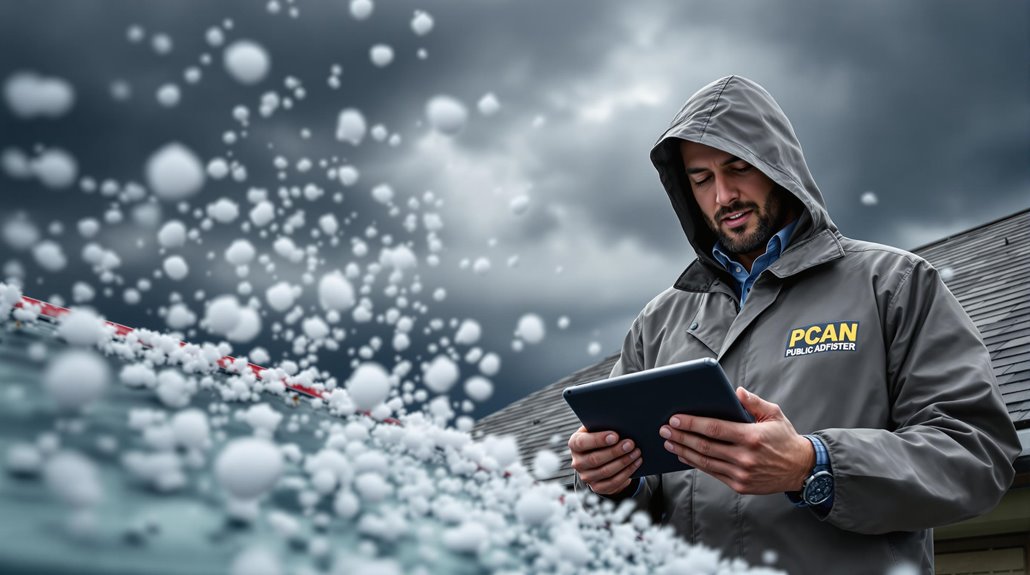
Professional public adjusters within PCAN serve as dedicated advocates for policyholders during insurance claim processes. The network comprises licensed professionals who specialize in thorough damage assessment, documentation, and claim negotiation strategies.
These experts utilize industry-leading software to guarantee accurate evaluation of losses and maximize settlement outcomes.
PCAN members provide essential services including detailed property damage analysis, emergency mitigation coordination, and temporary repair arrangements. Public adjuster roles encompass both residential and commercial claims, with expertise spanning various damage types, including hail, fire, and water-related incidents.
The network operates on a contingency fee basis, eliminating upfront costs for policyholders.
The organization maintains rapid response capabilities, often conducting on-site assessments within hours of incident reporting. PCAN adjusters leverage their extensive experience to identify concealed damages that insurance companies might overlook, while maintaining continuous communication throughout the claims process to guarantee ideal settlement results.
Frequently Asked Questions
Can Hail Storms Trigger Car Alarms, and Should I Disable Them?
Hail storm damage can trigger car alarms through physical impact and vibrations. Adjusting car alarm sensitivity is recommended rather than disabling, as deactivation compromises vehicle security and may violate insurance requirements.
How Long Do Typical Hail Storms Last in Different Geographical Regions?
Typical hail storm duration averages 15 minutes nationwide, with longest events occurring in Rocky Mountain regions. Regional variations exist, with Hail Alley experiencing more frequent storms throughout spring and summer months.
Does the Temperature Outside Affect the Size of Hailstones?
Temperature differences between ground level and upper atmosphere greatly influence hail formation, with greater temperature variations enabling larger hailstone development through extended periods in supercooled cloud environments.
Can Modern Solar Panels Withstand Severe Hail Impacts?
Tests show 4mm-thick solar panels lose only 1.1% power from hail versus 21.8% for thinner panels. Modern solar panels with UL 61730 certification demonstrate significant hail impact resistance, withstanding stones up to 3 inches.
Are Weather Apps Reliable for Predicting Exact Hail Sizes?
Weather apps show limitations in predicting exact hail sizes, despite advanced technology. Current hail prediction accuracy varies due to complex meteorological factors and technological constraints in radar and sensing systems.
References
- https://www.amfam.com/resources/articles/safe-and-happy-family/what-to-do-during-a-hailstorm
- https://www.progressive.com/answers/tips-for-driving-in-hail/
- https://www.unionmutual.com/tips/hail-storm-safety/
- https://www.cooperators.ca/en/resource-centre/stay-safe/preventing-hail-damage
- https://www.nationwide.com/lc/resources/emergency-preparedness/articles/hail
- https://hazards.fema.gov/nri/hail
- https://www.collisioncraftsman.com/five-warning-signs-of-your-destruction-from-hail-damage-repair
- https://www.thepersonal.com/blog/-/how-to-prepare-for-a-hailstorm
- https://ezautospa.com/25122/hail-damage-statistics/
- https://www.nssl.noaa.gov/education/svrwx101/hail/detection/
